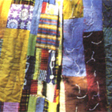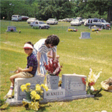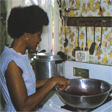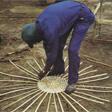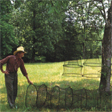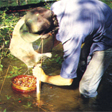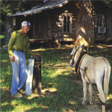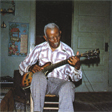
North Central Louisiana: An Historical Overview
By Glynn Ingram
At the end of the 18th century, when sugar cane and cotton helped make South Louisiana a booming financial success, the north central Louisiana hill parishes of Bienville, Claiborne, Jackson, Lincoln, and Union were still inhabited only by the Caddoes and other scattered Indian tribes. Even as late as the Louisiana Purchase in 1803, Fort Miro, on the Ouachita River, in Ouachita Parish, and Natchitoches, on the Red River, in Natchitoches Parish, were the closest permanent settlements to the five-parish area. Trappers, hunters, and traders, like the legendary John Honeycutt, brought furs and hides out of the hill section as early as the 1790s. But the tangled underbrush and wilderness, along with the absence of adequate trails and navigable waterways, discouraged even the hardy hordes of settlers beginning to roll across the southern states in the late 18th century. In 1812, however, Daniel Colvin of Tennessee moved his family near what is presently Vienna, in Lincoln Parish, and established the first permanent white settlement in the five-parish area, Colvinville (Gilley, 1984: 27-8). This established a migration pattern, which drew over 30,000 people to the region at the time of the 1850 census (U.S. Dept. of Int.). As people came, organized government followed, and by 1848, Bienville, Claiborne, Jackson, and Union parishes had been carved out of the former parishes of Natchitoches and Ouachita. In 1873, as part of the Reconstruction plan, Lincoln Parish was formed from portions of Jackson, Ouachita, and Union (Harris 1886: 21-22).
The first settlers in the region found a wilderness filled with wild game for food, including deer, turkey, squirrel, and rabbit, as well as a soil and climate which easily and abundantly produced all the crops necessary to feed both themselves and their livestock. What they also found was land, which would produce that agricultural and financial staple of the ante-bellum South-cotton. Here, as in the remainder of the South, cotton quickly became the principal money crop. At a time when owning fertile farm land equaled self-sufficiency and success, the presence of cheap cotton-growing land in the hill parishes created a strong lure to the agriculturally-oriented citizens throughout Tennessee, the Carolinas, and the remainder of the deep South. As early as 1824, Thomas Moore constructed a gin for Adam Reynolds in Claiborne parish, and by the 1840s, gins were scattered throughout the five-parish area (Claiborne 1956: 8).
The people who were drawn to the hill parishes by the cheap farmland represented all the ethnic groups found on the Atlantic seaboard, but it was the Scotch-Irish who proved the wedge and driving force of the parishes. And it was the Scotch-Irish, with their strong Protestant ethic, who gave the region its distinctive social, ethical, moral, and religious character. These people were a hardworking lot, strongly imbued with the Calvinist belief that those who worked hard and held to their faith would succeed. These self-reliant, pragmatic people assumed God would help those who helped themselves and that industry and thrift were reflections of character and not just of ambition. From the early 19th century to the present, the character drive, and sense of moral uprightness typical of the Scotch-Irish has been the single most dominating influence of the north central parishes of Louisiana (Hanna: Leyburn 1962: 322-24).
When the settlers came, perhaps the single most important institution they brought with them was a strong Protestant religion. The overwhelming majority of these people were Baptists, a statistic, which holds even today, while the Methodists and Presbyterians made up the remainder of the Protestant population. While South Louisiana, with its large French population, was dominantly Catholic, only a half dozen Catholic churches existed in the entire five-parish area before the Civil War. James Brinson, a Baptist preacher from Tennessee, brought organized religion to north central Louisiana in 1821, when he organized the first Baptist Church in North Louisiana at the Pine Hill Baptist Church in Upper Pine Hills, near Vienna (Cook 1983: 1-12; Gilley 1984: 118-9). Over twenty years later, in 1848, the Louisiana Baptist Convention was organized at Mount Lebanon in Bienville Parish. In subsequent years, other Protestant denominations followed the Baptist, Methodist, and Presbyterian churches in the area, but from Brinson's move in 1821, the Baptist church has been the church of the people, black and white alike (Gilley 1984: 113-6).
Agriculture constituted the principal livelihood in north central Louisiana before the Civil War. Like the remainder of the South, this part of Louisiana turned to black slavery to supplement the family work-force. But slavery, while it was widespread, never thrived in the hills as it did in the far more fertile land of the Mississippi Delta or the flood plains of the Red and Ouachita Rivers. The table below affords a good picture of the total white and slave population, and presents a good picture of the extent of slave ownership in 1850.
|
Total Pop. |
Whites |
Slaves |
House- holds |
Owners |
average/ Owner |
Over 20 |
|
|
Bienville |
5620 |
3728 |
1892 |
572 |
231 |
8.19 |
27 |
|
Claiborne |
7431 |
4909 |
2522 |
842 |
330 |
7.61 |
33 |
|
Jackson |
5560 |
3407 |
2153 |
580 |
269 |
8.0 |
19 |
|
Union |
8193 |
4778 |
3415 |
942 |
392 |
8.71 |
45 |
Thus it can be seen that about 41.6% of all householders in North Louisiana owned slaves and in the hill parishes, as in the remainder of the South, most slave owners fell into what has been called the yeoman farmer class rather than that of the plantation owner. Only about 10% of the slave owners in the region fell into the planter class -- that is, people who owned 20 or more slaves (U.S. Dept. of Int.). Most owners could not afford to hire slavedrivers and overseers. Most of the owners worked with their slaves and did much the same manual labor as their charges. The close contact between slave owners and slaves joined in common tasks had important social and cultural results, for with this contact came emulation. While the white South was influenced in many ways by the black heritage and culture, the influence of white on black was without question the stronger (Owsley 33-48, 7-10).
When the Civil War came in 1861, north central Louisiana, like the remainder of the nation, was caught in the jolting emotional upheaval preceding the coming fight. There were isolated spots of Unionism in the region, particularly in Union Parish, but by and large the men who volunteered to fight in the war joined the Confederate Army. Companies were organized in Vienna, Homer, Farmerville, and many other towns in the area, and it is safe to say that the greatest contribution of north central Louisiana to the Civil War was in the hundreds of Confederate volunteers who fought on battlefields from Texas to Gettysburg (Winters 1963: 57-67).
The participation of these men in the military reduced the area's potential agricultural and economic contribution to the Confederacy's war effort, however. With the sudden loss of so many young men, managing the land and maintaining the crops became increasingly difficult. An added problem, too, was an old one in the section-lack of transportation. Before the Civil War, cotton was ginned and then taken by wagon to the various creeks and bayous, which flowed into the Red and Ouachita Rivers, from whence it was transported to the textile mills of the Atlantic seaboard. When the Union fleet gained control of first the Mississippi River and then much of the Red and Ouachita Rivers, the cotton got no farther than the gins or warehouses. Thus little good came from the cotton grown between 1863 and 1865. The problems which plagued the cotton producers also stifled the farmers who tried to produce corn as forage for the horses and mules used by the Confederate Army (Wilder 1971: 1-7; Shugg: 1939, Passim).
However, the hill area provided a solution to one problem faced by the Confederacy during the Civil War, namely the critical shortage of salt. Prior to the Civil War, most of the salt used in the South was either imported or produced in facilities along the coastline. With the Union naval blockage, the ante-bellum salt sources disappeared and were partially replaced by salt from Bienville Parish. The Lake Bistineau Salt Works, Raburn Salt Works, and King Salt Works were sites long known for their ability to provide abundant amounts of high quality salt. During the war, when salt supplies dwindled quickly, Bienville Parish became the center of a large salt traffic as individuals poured into the area to extract salt from the brine removed from the underground salt domes. Reports show that people came as far away as Texas, Mississippi, and Arkansas to extract the salt and that several produced salt under contract for the Confederate government. It is estimated that during the last two years of the Civil War, Bienville Parish was the single most important source of salt for the Confederate government (Cook 1970: 1-9).
The parish also helped alleviate another problem experienced by the Confederacy -- a shortage of medicine for military use. In 1864, when the Confederate government was hard pressed on all fronts, Louisiana Governor Henry W. Allen appealed to Dr. Bartholomew Egan to establish a laboratory to produce medicine for the Army. Dr. Egan bought out the facilities of Mount Lebanon Female College in Bienville Parish and immediately began producing large quantities of turpentine, castor oil, opium, and medicinal grades of whiskey. The laboratory closed shortly after the Civil War ended, but while it was open, it produced enough medicinal supplies to supply the Confederate army in Louisiana in late 1864 and 1865 (Winters 1863: 408-9).
A dubious distinction of the region during the Civil War was that the densely wooded countryside served as an ideal hiding place for deserters and draft dodgers. In 1863, General Richard Taylor sent five companies of soldiers into Winn and Jackson Parishes to round up deserters, arrest conscripts who failed to report, and break up jayhawkers who were terrorizing the countryside and acting like gangs of brigades. Late in 1863, a group of deserters and draft dodgers in Union Parish even went so far as to organize themselves as a military unit in anticipation of an expected attack from soldiers sent by General Kirby Smith. While this and all other skirmishes and raids by deserters, dodgers, and jayhawkers were put down, the section was constantly threatened by the non-Confederate supporters down to 1865 (Winters 1863: 306-7).
Once the Civil War ended, Louisiana and the hill parishes faced Reconstruction, a period almost as traumatic as the Civil War itself. When the carpetbaggers, Scalawags, and the free blacks took control of the Louisiana government in 1868, under Governor Henry Clay Warmouth, unity between the people and the government, which ruled them disappeared. In north central Louisiana, both blacks and whites faced grave problems, problems associated with either the working or owning of land. Blacks, who made up over 40% of the population in the five-parish area, now found themselves without jobs and by and large without land. Moreover, those whites who owned land, both former slave owners and non-slave owners, were faced with financial ruin and could not afford to hire blacks as laborers for what was a devastated agricultural system. What resulted was an agricultural system where sharecropping, share-renting , or the crop lien method was used to work the land. It was a system which satisfied the needs of both the newly freed blacks and the impoverished whites, because without land to work or cash to buy either land or supplies, these classes were thereby provided economic security without capital outlay (Taylor, 1974). Each sharecropper and his family were responsible for an average of twenty acres, with the owner providing the land, seed, and perhaps equipment. Most sharecroppers had a hog or two and grew vegetables for their own use (Highsmith 1964: 25). Seeking a better position, sharecroppers frequently moved from farm to farm (Smith and Hitt 1952: 218).
One serious long-range problem resulting from the different forms of sharecropping was that the people actually farming the land needed to turn a profit to pay both themselves and the landowner from whom they rented the land. The result was an even heavier reliance on cotton because this was the crop which brought money. Over the years, as cotton was repeatedly planted on worn out soil and then as the Mexican boll weevil moved into Louisiana in the 1890s, the production of the land dropped and the economic fortunes of the people declined, throughout the South and in North Louisiana (Taylor 1974).
In the post-Civil War period, while industrialization and the New Immigration were radically changing the social, economic, and cultural character of the United States, the South in general, and the hill parishes in particular remained largely unchanged. The hill parishes of North Louisiana remained overwhelmingly agricultural in the late 19th century, with little industrial intrusion and little change in the ethnic distribution. One of the things which helped create this static condition was the section's relative isolation combined with the absence of waterways and railroads. By 1840 there was one significant road across North Louisiana connecting Shreveport and Monroe built along the old Ouachita Trail, a road popularly known as the "wire road" because the telegraph lines ran parallel to the dirt highway. This served both stage and freight lines, but the rains made the dirt road impassable in some months of the year and made the route too rough and unreliable as a practical commercial route with the outside world (Wilder 1971: 1-20).
Railroads, the real transportation boon of the industrial age, did not reach the hill parishes until 1883. As early as 1852, a concerted movement had been made to organize and build a railroad across North Louisiana from Vicksburg to Shreveport and Texas Railroad Company was organized and stocks in the company sold to finance the venture. However, over the next two years the project was delayed by a virulent outbreak of yellow fever, broad flooding of the proposed track line by the Mississippi River, over-speculation, and lagging profits on stock subscriptions. With the Civil War, plans for a railroad were delayed indefinitely (Legan 1976: 125-42).
In the late 1870s and early 1880s, interest in building a railroad across North Louisiana revived again and in 1883 the Vicksburg, Shreveport, and Pacific railroad company was organized. The opening of the company's line between Vicksburg and Shreveport in 1884 opened a whole new chapter in the history and economy of the five parishes and, as one writer noted, it also ended the frontier period in North Louisiana. Once thriving and important towns were missed by the railroad and soon died -- places like Ouachita City in Union Parish, Mount Lebanon in Bienville, Arizona in Claiborne, Vernon in Jackson, and Vienna in Lincoln and soon, new towns cropped up along the new railroad, including two new future parish seats: Ruston in Lincoln Parish and Arcadia in Bienville Parish. Soon afterwards, in 1899, a North-South railroad, running through Claiborne, Lincoln, and Jackson, was opened up by Rock Island Railroad. Over the past ninety years, numerous spur lines have been constructed, giving most of the five parishes good railroad access (Cawthon 393-402).
One valuable hill parish resource that had not been utilized by the people or by businesses to any significant extent before the 1890s was timber from the virgin shortleaf forests. According to the 1880 Agricultural Census, Union, Claiborne, Bienville, and Jackson parishes had a combined total of 7.95 billion board feet of marketable shortleaf timber, a total as large as that of any comparable land area in the entire South (U.S. Dept. of Comm.). Now, the transportation afforded by the new railroad, the booming demand for milled lumber, and the large and cheap source of local labor brought the sawmill era to North Louisiana. Between 1890 and 1915, towns like Yellow Pine, Ansley, Hodge, Bienville, Alberta, and Haynesville became the North Louisiana version of boon towns as billions of board feet of shortleaf pine came pouring out of the area. The golden year of the timber industry in Louisiana was 1913 when over 5 billion board feet of lumber was produced, more than any other year in the history of Louisiana's timber industry. The five-parish area, which saw companies like Globe Lumber Company, David Brothers Lumber Company, Hodge-Hunt Lumber Company, and many others operating, was part of the bonanza (Lindsey 1970: 17-25; Harrington 1979).
However, with the financial harvest came some serious problems. In a day when "cut out and get out" was the rule and when conservation or reforestation were new terms, much of the region went from land with dense stands of virgin shortleaf pine timber to badly cut-over, erosion prone rolling hills. In the period of World War I, when the more astute foresters began to realize the long range damages of the lumber industry, Henry Hardtner of Olla began the pioneer reforestation work which would earn him recognition as the father of Louisiana reforestation. For North Louisiana, reclamation of the forest land came with the reforestation programs of the 1920s and 1930s, and with the help of companies like Urania Lumber Company and Olla and T.L. James Company of Ruston, the correction of a serious problem began. However, when the depression began in 1929, much still work remained to be done (Humphreys 1964: 345-67).
The work of the Civil Conservation Corps established by Franklin Roosevelt's administration in 1933 helped bring the timber industry back as an important economic endeavor in the area, along with the Soil Erosion Service. The CCC began its work by hiring young men to plant pine seedlings, both on government property and on private land. In 1933, the first CCC camp in the United States organized exclusively for soil erosion work opened in Minden, followed shortly by a camp at Cypress Creek in Lincoln Parish, a short distance from Ruston. Both camps helped impress the people of the adjacent parishes with the advantages of systematic soil control and helped save what in some cases was badly endangered land (Humphreys 1964: 345-67).
The saw timber industry which peaked in Louisiana in 1913 declined in large part because the virgin strands of pine timber were cut off, leaving the diseased, deformed, and immature trees behind. In 1926, the Advance Bag and Paper Company from Howland, Maine, opened a new phase of timber-related industry in the five-parish area when it bought out the interest of Hodge-Hunt Lumber Company of Hodge, in Jackson Parish. The Advance Bag and Paper Company brought in a pulp paper plant which utilized trees unsuitable for the saw timber industry. Other paper mills opened in Bastrop, West Monroe, and Springhill and in each case these mills depended heavily on pulpwood from Union, Bienville, Jackson, Claiborne, and Lincoln (Harrington 1979).
Today, with the advantages of reforestation programs begun in the 1920s and with the development of new, faster growing strains of pine timber such as loblolly and slash pine, the timber-related industry in the five-parish area is one of the largest non-white collar industries in the region. In 1983, 15.8% of all saw timber and 20.2% of all pulpwood harvested in Louisiana came from the area and 17% of all income from the sale of timber in Louisiana came from the same region (Louisiana Timber 1983). In addition, the large national conglomerates of Willamette Industry, Manville, and Georgia-Pacific plan to expand their production of plywood, particle board and chip board, while other plants are processing piling timber for electrical lines, bridge pilings, and foundation pilings.
In the opening decade of the twentieth century, in 1904, when the timber industry in North Louisiana was reaching its peak, wildcatters from Texas drilled a pumping oil well in Caddo Parish, the first successful oil well in North Louisiana. Over the next twenty-five years major drilling operations began at Haynesville-Homer field and the Lisbon field in Claiborne Parish and the Oakland field in Union Parish. Today all five parishes have both oil and natural gas production and it is a common sight to see pumping rigs operating where cotton and other crops once flourished. In the 1981 oil and gas reports, Claiborne Parish ranked third among all parishes in the state in crude oil production, with 3.4 million barrels of crude oil, and Bienville Parish ranked 13th in natural gas production, with 42 trillion cubic feet (Louisiana Oil and Gas 1983; Hair 1977, 179-82). With the success of the petroleum drilling industry new jobs came for skilled and unskilled laborers alike and thousands of men were employed in jobs ranging from the technical services of engineers and geologists doing surveying and research down to the common jobs of oil field roughnecks. In the process much of the land which declined in value as its agricultural value fell now turned new money as oil and gas royalties were paid to the landowners by the petroleum industry.
Agriculture, once the life-blood of north central Louisiana, has become much more diversified in the twentieth century as people have turned from their earlier dependence on cotton to produce other money making goods. Truck farming has become popular in much of the five-parish area, while in recent years soybean production has been the new money crop for farmers. In Lincoln Parish peach orchards flourish, the majority of the peaches produced in Louisiana coming from the farms of Dennis Owens in Hico and J.E. Mitcham in Ruston. The dairy and beef cattle industry has also flourished as has a relatively new poultry industry. The diversified agriculture has provided farmers a way to work the soil on a part-time basis without being as tied down by time-consuming farm production as they had been in the cotton-producing period of the 19th century.
Politically, the hill country has been a conservative section. Until the 1960s the region, like the rest of the deep South, voted solidly Democratic, associating Republicans with Reconstruction. It is a section, too, which has always been more intensely concerned with local than with state politics. In the Huey Long era, when North Louisiana in general gained more political leverage, the voters realized it was possible to use the political influence to gain favors which had long been the monopoly of the more populous and politically powerful southern part of the state. Under Long's guidance, the section at last got respectable roads and bridges and free textbooks in schools, but more importantly, the section realized it might have real political impact. In recent years the five-parish area has helped elect such North Louisiana gubernatorial candidates as John McKeithen, Jimmy Davis, and Robert Kennon. Another noticeable political change has been the rising influence of the Republican party and for the first time since Reconstruction the Republican Party, now perceived by North Louisianians as the more conservative of the two major national parties, has fared well in North Louisiana. Relatively few local candidates run or are elected on the Republican ticket, but in national elections the Republican Presidential candidates have consistently drawn heavy votes in north central Louisiana since 1964, reflecting the region's tendency to regard local autonomy and fiscal responsibility as key issues on the national front.
In the Protestant hill country, education has always been a primary concern and this concern is reflected in the number of schools established over the years. As early as 1825, when settlers were clearing land and building houses, John Murrell, in old Claiborne Parish, opened a school in his home for area children. When other settlers came, they followed Murrell's example and established private schools because parents believed all children should have the rudiments of education in order to read and study the Bible. By the Civil War, academies for males and females opened in Homer, Farmerville, Mt. Lebanon, and other places, and in 1855 the first college in North Louisiana opened its doors at Mt. Lebanon in Bienville Parish. Each of the five parishes after they were chartered, maintained public schools and collected taxes to support these (Harris 1886; Gilley 1984; 127-9). In 1890 the region got an added incentive to train teachers and provide a public forum for educational speakers when the Louisiana Chautauqua Association opened the Louisiana Chautauqua in Ruston. The project flourished for about fifteen years before it finally closed in 1905 and the property of the Chautauqua was sold to James L. Martin. In 1906 a similar project started for blacks at Grambling when the Louisiana Colored Chautauqua was organized (Smith 1974: 138-42).
In 1884 the push for higher education resulted in the opening of Ruston College, a venture which lasted about ten years. In 1894 Louisiana Industrial Institute and College, an institution which later became Louisiana Tech University, was chartered by the state Legislature. The area boasts a second college at Grambling, a university founded in 1901 through the efforts of Charles Adams (Carter 1976: 401-12; Graham 1934: 54-5).
Because the five-parish area has only a limited industrial work force, the average annual income for whites and blacks is below the average for the state. In 1979 the average annual income for whites in the five-parish area was approximately $20,000 and for blacks $11,700. This compares with the state average annual income for whites at $24,280, and for blacks at $13,608. Additionally, the poverty level, a general measure of the quality of economic life, shows that the whites who live below poverty level in the five-parish area ranges from 7.7% in Claiborne to 14.0% in Jackson while the range for blacks below the poverty level varies from 29% in Lincoln to 39.3% in Bienville (U.S. Dept. of Int.).
Today the ethnic distribution of the five-parish area remains essentially unchanged from the Civil War and the area is still predominantly a rural one where Lincoln Parish, with a 62.4% urban population is the only parish in the area with an urban population that exceeds 45%. There are no major metropolitan areas in the region and Ruston is the only town in the section with a population over 20,000. In 1980 the total population of the five-parish area was 111,131, less than the population of several cities in the state (U.S. Dept. of Int.).
How long the region will retain its essentially rural character is a subject of some interest, however. The opening of Interstate Highway 20 across North Louisiana has brought national industries like Willamette and Laurens Glass to the area and changed the work patterns of area citizens. The presence of Lakes D'Arbonne in Union Parish, Claiborne in Claiborne Parish, Kepler in Bienville Parish, and Caney in Jackson Parish has attracted tourists and sportsmen. These recreational areas along with the low tax rate found throughout the north central parishes have also made the region a popular retirement area for people throughout the United States. Indeed one group of urban planners has projected a model "linear city" which would extend from Monroe to Shreveport along Interstate 20 and make accessible to area residents all the transportation facilities, varied workplaces, businesses, and diverse cultural opportunities of a large American city. The question remains how these changes and possibilities, each of them a threat to the traditional, rural character of the region, will affect the north central Louisiana parishes.


